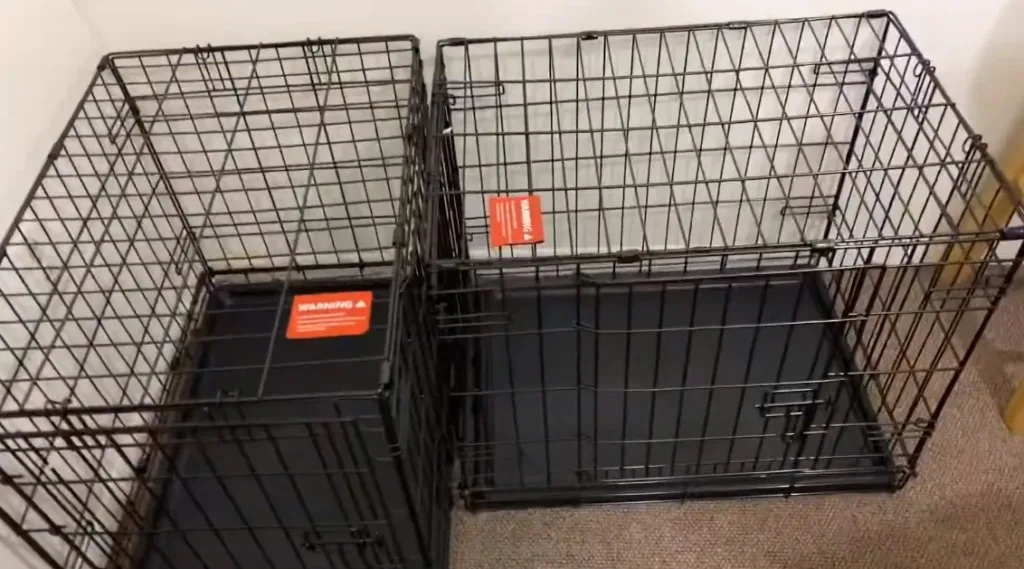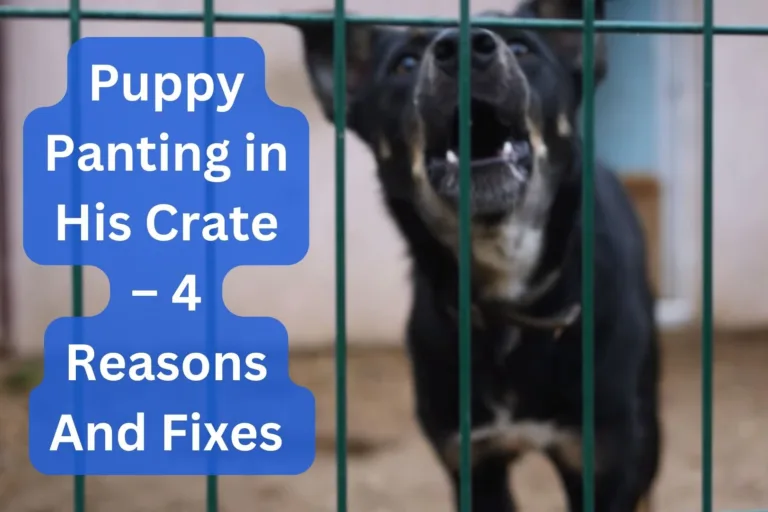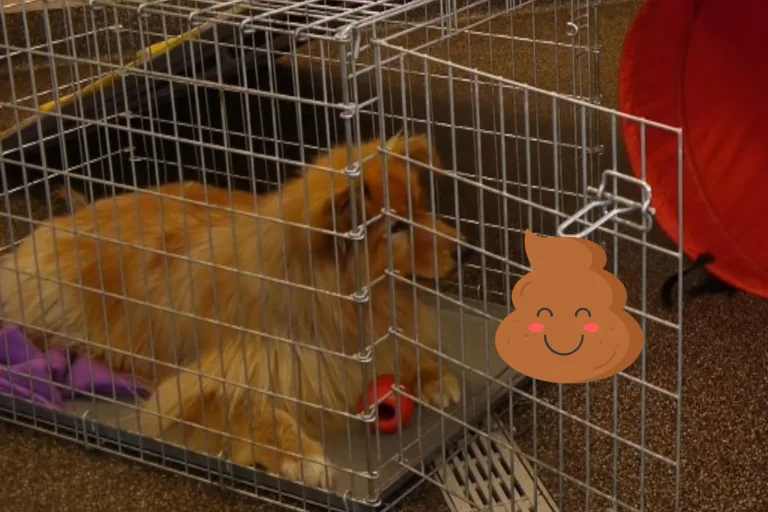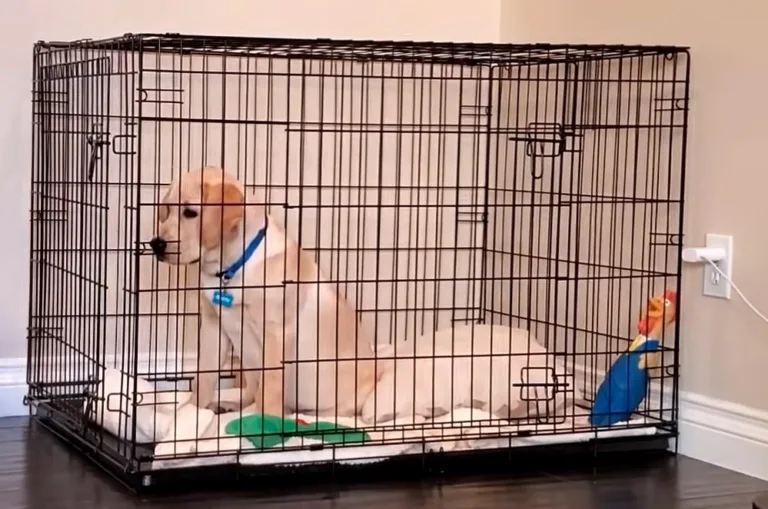Can Dogs Share a Crate? A Definitive Answer
Crate training one puppy is hard enough, but taking on the job of training multiple at once can be extremely exhausting. That’s exactly why many dog owners prefer to crate train multiple dogs inside the same crate.
They often assume that the dogs will keep each other entertained and, thus, learn to love their crate over time. Besides, buying one crate instead of two is much easier on the wallet.
However, the real question is: Can dogs share a crate? More importantly, should they?
Our answer is no. While dogs do enjoy snuggling with each other, they often require their own space when looking to escape from all the sensory stimulations of the world. Another dog intruding in their space may cause them to panic and exhibit aggressive behavior, especially if the crate door is locked.
Want more insights into what happens when dogs share a crate? Take a gander at the guide below to get all your questions answered.
Table of Contents
Can Two Dogs Share a Crate?
Dogs, like humans, value their personal space, and the presence of another dog can often disrupt the peacefulness of their sanctuary. Let’s dive deeper into why two dogs can’t share a crate by understanding a dog’s idea of personal space.
Dogs and Their Personal Space
If you have two or more pups at home, you might’ve noticed them bouncing around each other when they’re excited. You might’ve also noticed them giving each other an occasional playful bite.
This is very much by design, as dogs mainly communicate with each other through their body language.
Apart from wagging their tails (a classic sign of excitement), dogs use plenty of other body language signs to send messages to each other, including play-bows, jumps, and barks. Plus, they’ll also gently bite each other from time to time to display their affection.
Thus, the typical problem with inserting two dogs in the same crate is that they’re not left with enough room to communicate properly.
That can frustrate them over time, with that frustration slowly turning into anger and aggression. And that pent-up aggression may cause them to get into fights and possibly injure each other.
Never Crate Dogs Together to Force Them into Getting Along
As a parent of multiple dogs, you will eventually encounter the problem of your dogs not getting along. It may even get to a point where they get annoyed at even the sight of each other.
Now, we realize that your first instinct at this moment might be to try to force them to get along. But leaving them in a crate or room together is definitely not the way to do that.
You have to remember that our furry friends don’t have the same brain as us and can’t “talk it out.” What can, however, happen is that they start fighting each other, and one or both of them gets seriously injured. And no one wants that.
So, to sum up, if anyone asks you: Can dogs share a crate? Or should I crate my dogs together to stop them from fighting? Your immediate response should be no.
What Can You Do Instead?
It’s quite obvious, but we’ll say it anyway, separate crates for each dog. If your dogs are all friendly with each other, you can even place their crates together.
This way, they’ll get to interact a little bit without being frustrated at each other for infiltrating their space. It may get a little rowdy at times with all their barking, but at least they won’t be taking jabs at each other.
Can 2 Dogs Share a Crate on a Plane?
Absolutely not. Think of the panic you feel when a plane’s taking off or landing. Better yet, think of how you feel when the plane starts experiencing turbulence. Now multiply that panic tenfold.
That’s the kind of panic your pups are feeling while they’re trapped in a foreign environment that they haven’t yet adjusted to. The uncertainty of the environment alone may lead to your dogs experiencing significant stress.
And if they’re trapped in a crate together, that travel stress may turn into aggression, causing them to lash out at each other. Most international travel agencies don’t allow two or more pups to travel in the same crate.
However, even if yours does, make sure to put them in separate crates as a rule.
When is it Safe to Put Several Dogs into One Crate?

We’ve already discussed how dogs have a sense of wanting their own personal space. Small puppies, however, don’t develop that sense until they’re about 8 weeks old.
Thus, it is safe to keep several puppies, preferably from the same litter, in the same crate, as they’re quite used to getting touched and cuddled by their littermates.
But make sure you monitor them closely and start preparing separate crates for them as they get closer to reaching the 8-week mark.
Can Two Dogs Be Put into a Playpen?
A playpen is very different from a crate. It’s larger and more spacious, thus providing each dog with their own space that they can comfortably move in.
So, to answer the question: Yes, you can keep two dogs in a playpen together. However, you have to ensure that both dogs have enough space in their combined pen to signal each other using their body language.
Also, make sure you keep separate beds in there for them, as dogs don’t typically like cuddling with each other when they’re sleeping (apart from some breeds).
Can 2 Dogs Share a Crate in The Car
Just like in planes, dogs should not be crated together in a car. While your dogs may be a bit more acclimated with your car, it’s still unfamiliar territory for them, especially compared to the house.
That, on its own, can make dogs feel anxious and slightly scared. Additionally, dogs tend to react to every sound they hear outside (a siren, other cars passing by).
Their excitement becomes difficult to suppress, which could turn into aggression against the other dog if they’re both crated together.
Known Benefits of Crating Two Dogs Together
Now, the important thing to understand here is that when we say “together,” we don’t mean placing them in the same crate. We mean placing them in separate crates but placing both crates close together.
Not only does that allow your pups to interact with each other, but it also instills in them a degree of comfort and security, knowing that their friends are next to them.
Learn and Pay Attention to Their Body Language Signs
As we said earlier, dogs majorly communicate with each other through body language. So, if you have decided to make your two dogs share a crate, you must monitor their body language closely and learn what their actions mean.
This holds for little puppies that come from the same litter as well. As soon as you start to notice either dog exhibiting any aggressive behavior, you need to remove one of them from the crate at once.
Acclimate Them with Each Other Before Putting Them in The Same Crate
You may want your dog to learn how to share his space with his brother or sister. In that case, there are a few training drills you can practice.
Firstly, try to get both to share a crate and some of their toys as well. This will allow them to learn each other’s body language signals and learn how to share resources.
Make sure the crate is sufficiently big enough for both of them to walk around comfortably. If either dog starts to act up, remove one of them instantly.
You can then try to familiarize the dogs with each other once again using exercise pens. Once you feel that they’ve sufficiently acclimated to each other’s presence, put them back into the same crate again.
Downsides of Crating Two Dogs Together
Like humans, every dog’s temperament is different (this is especially apparent in different breeds). While they may enjoy spending some time together, being locked in a crate for hours on end may make them feel irritated or anxious.
The size of the crate can be a big factor in this as well. A crate that’s too small for full-grown dogs may make them feel cramped for room, which could make them aggressive.
In cases like this, it’s better to keep each dog in a separate crate. The crates can still be close in distance, but each dog should be given their own space.
Factors to Consider When Dogs Share a Smaller Space
If you do decide to crate two dogs together, you need to keep several factors under consideration. Firstly, make sure you choose the right size and location for the crate.
The crate should be big enough to allow both dogs to sit, stand, and move around. Plus, it should be placed in a relatively secluded room/area in the house.
Assuming you adhere to these requirements, the quietness of the environment should keep your pups relatively calm throughout the day.
Do keep monitoring them every chance you get, especially during the early days when they’re both adjusting. If you see even a hint of aggression from either of them, move them into separate crates immediately.
How to Crate Train Multiple Dogs
We’ve already mentioned how crate training can be hard and time-consuming. That said, it can also be incredibly rewarding once you complete it. Luckily for you, we’ve come up with a few tips to help you crate-train multiple dogs at once.
- Start as early as possible. Younger puppies are much easier to crate train together as their idea of personal space is almost non-existent.
- Introduce them to their crate slowly by bringing each dog over when the crate door is open. If they jump in on the first try, then it’s a bonus.
- Fill the inside of the crate with bedding and toys to make it feel like a comfy home.
- Praise and treat your dogs every time they go in, and feed them inside the crate.
Solving The Resource Guarding Problem
You may have seen kids guarding their toys when guests visit the house. Well, young dogs behave similarly when they’re being crate-trained together.
They may start guarding any resource they believe they “own,” including food, water, and toys. This is a built-in defense mechanism that allows them to survive in the wild.
The best way to teach your dogs to share their resources is through positive reinforcement. Here are some tips you can follow:
- Feed all of them at the same time. A consistent feeding schedule can go a long way toward making them believe that they will each get separate portions.
- Praise and reward them when they don’t lash out at the other dog for being near their “stuff.”
- Place each food bowl at a certain distance to prevent any disputes.
Crate Training Challenges for Multiple Dogs
In addition to asking, can my dogs share a crate, new dog parents often question if they can crate train multiple dogs together. Now, while it is possible, you can run into a few challenges when crate-training multiple dogs.
Dogs can be extremely protective of their parents. Thus, one of them could end up lashing out in jealousy if you start giving the other one a bit more attention.
However, that isn’t the end of the world, and pups do learn to be comfortable with each other over time. All you can do is try to give each pup the same amount of individual attention and praise.
On the other hand, you could run into a problem of the dogs loving each other’s company too much. They could wreak havoc in the crate with all their excitement and might even injure each other.
The only thing to do then is keep them in separate crates but keep the crates close to each other.
Why Dogs Need Their Own Personal Space
Dogs evolved from wolves, and thus, their natural instinct is to come back to their den for some solitude. This period of rest and relaxation helps them find a temporary escape from the chaotic nature of the world.
Thus, when another dog enters its den, he recognizes it as an intrusion into his space and can lash out at the intruder. Closing the crate door doesn’t help either, as it can make the dog feel trapped, which can quickly turn him aggressive.
Littermates are The Only Exception
Young puppies under the age of 8 weeks don’t have such strong sense of personal space as older dogs do. Thus, moving them together into a single crate can be much easier.
The same rule also applies to littermates, as they identify each other as their brothers or sisters. Therefore, their aggression towards them is quite toned down and almost non-existent.
That said, it’s still important to monitor them closely to detect if there is any animosity building up between them.
What Works Better: Separate Crates or Shared Crates?

Having discussed all that we have in the post until now, it’s time to decide which works better: Shared crates or separate crates.
We’re still leaning towards separate crates for each dog, especially if you’re going to leave them in there for hours on end while you’re at work or running errands.
It gives each pup their own space to play, sleep, or hang out according to their own schedule. Plus, it’s safer as you won’t have to worry about your dogs attacking each other while you’re out.
On the other hand, certain pups seem to gravitate to each other and want to spend as much time as possible together.
In that case, shared crates might be the better choice. At the end of the day, the answer to the question, can dogs share a crate, depends on your dogs’ willingness to be near each other.
FAQs Concerning Can Dogs Share a Crate
How Do You Crate-Train Multiple Dogs at Once?
Proper crate training is only possible through patience and positive reinforcement. Introduce the crate to your dogs slowly. Reward them with treats and praise them when they enter their crate for the first time. Establish a routine and gradually start increasing the time they have to spend in there.
Can You Crate Train One of Your Pooch and Not the Other?
Yes, sometimes it can be beneficial to crate-train one dog only depending on their specific needs and how mischievous they are. However, we’d recommend crate training all of your pups.
Is Crate Training Right for Every Dog?
While crate training is advised for when you bring a dog into your home for the first time, you’re not necessarily required to continue the practice.
It can actually be dangerous to keep dogs that are temperamental, plagued with health issues, or above a certain age in a crate. So, make sure you consult a professional for guidance beforehand.
Do Multiple Dogs Need Multiple Crates?
This once again comes back to the question: Can two small dogs share a crate? And for the most part, the answer remains no.
So yes, multiple dogs will need multiple crates. The only exception to this rule is if they’re littermates or under the age of 8 weeks.
Can You Put Two Dog Crates Next to Each Other?
It depends on if the dogs are friendly with each other. Friendly dogs enjoy each other’s company, even across a fence, and can keep themselves entertained. Aggressive dogs, however, will bark and growl at each other all day, which will eventually start to annoy you.
Can Dogs Share a Crate? The Final Verdict
And that brings us to the end of this guide, folks. Now that you’ve read all the information provided in this guide, what do you think? Can dogs share a kennel?
Our final verdict remains a no, only because we know how much dogs value their personal space. Their sense of territory, when disrupted, can cause them to be quite aggressive, which can result in fights and serious injuries.
The only exception to this rule is when dogs sharing a crate are littermates or under the age of 8 weeks. Even then, they have to be carefully monitored for any aggressive behavior against their crate mates.
Anyways, if you enjoyed this post, make sure to check out some of our more detailed guides on how to crate train a dog. That’s all from us. Have a great day!







